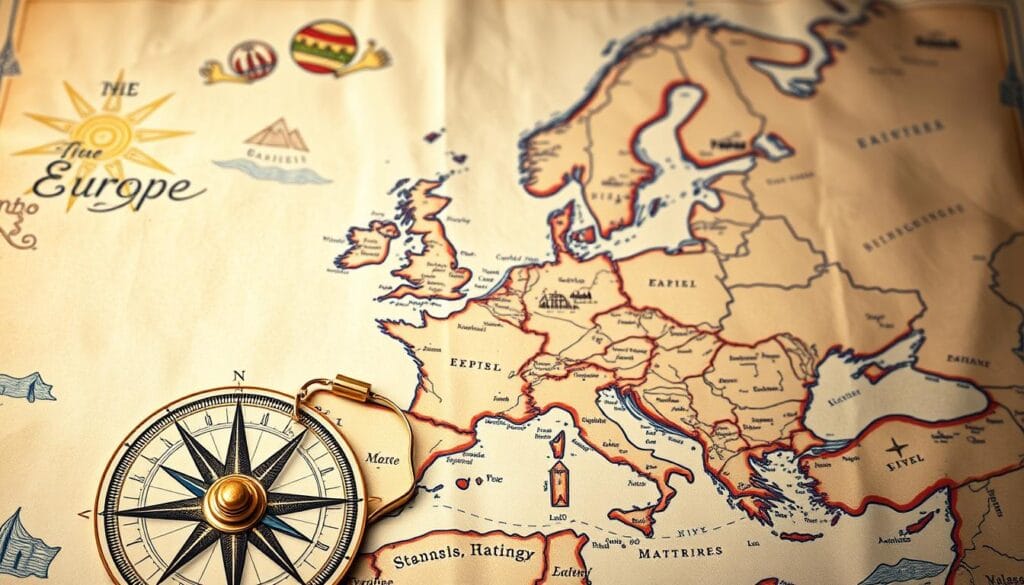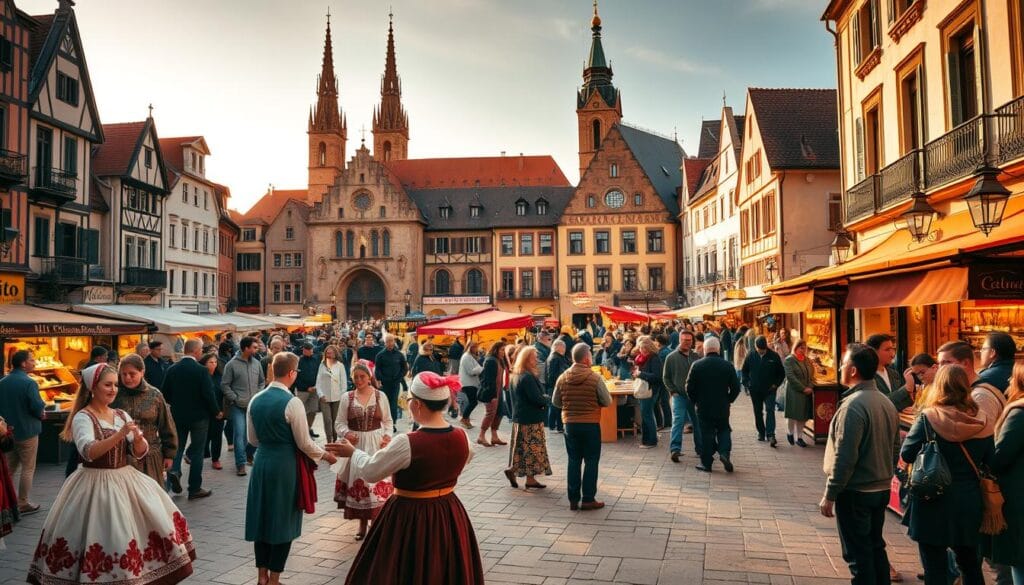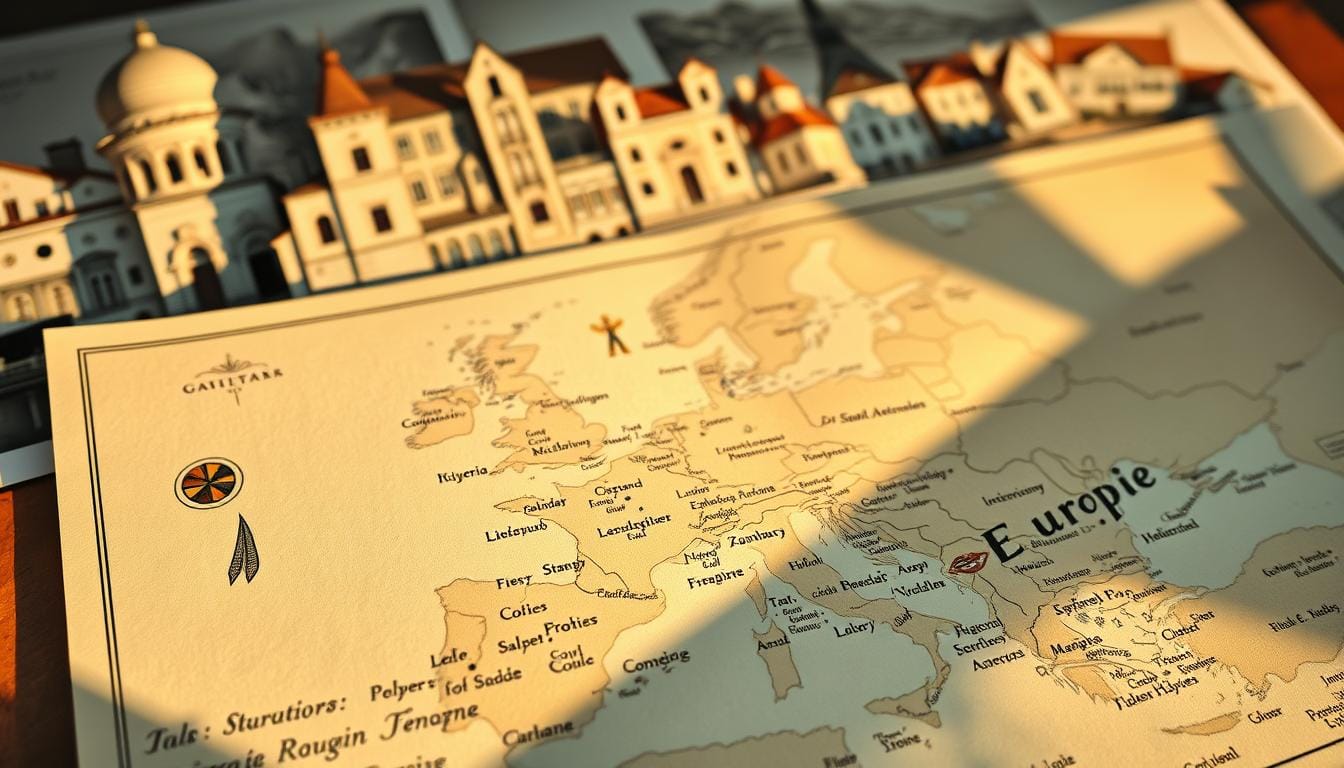Your Perfect Europe Travel Itinerary For First-Timers
Starting a European adventure can change your travel life. A good Europe travel plan lets you see amazing sights, learn about different cultures, and make memories that last. You’ll get to see many places.
When planning your first trip to Europe, think carefully. There are about 50 countries to visit. Making a smart plan is key. It can turn a good trip into an amazing one.
Europe has so much to offer. You can walk through Rome’s old streets or see Norway’s beautiful fjords. No matter if you have 7, 10, or 14 days, planning well lets you see more and stress less.
Table of Contents
Essential Pre-Trip Planning for European Adventures

Planning a European trip needs careful thought and detail. Whether you’re planning a budget trip or a luxury vacation, good planning makes a big difference. It turns a good trip into an amazing one.
Your journey starts with important documents and research. If you’re from North America, make sure your passport is ready:
- Passport must be valid for at least six months beyond return date
- At least one blank page required for entry stamps
- New ETIAS authorization system launching in 2025
Travel Documentation Essentials
Before you start your trip, gather these important documents:
- Valid passport
- Travel insurance
- International driving permit (if renting a car)
- Student ID for potential discounts
Budget and Financial Preparation
Smart money management is key for any trip. Here are some tips:
- Notify your bank about international travel
- Check credit card foreign transaction fees
- Carry multiple payment methods
- Have some local currency on hand
“Proper preparation prevents poor performance” – Travel Wisdom
Optimal Travel Timing
Choosing the right time to visit greatly affects your trip:
- Peak season: June to August (most crowded)
- Off-season: October to April (fewer crowds, lower prices)
- Recommended trip duration: 2 weeks
- Suggested destinations: 4-5 locations
Spending time on pre-trip planning sets the stage for an unforgettable European adventure. It balances excitement, comfort, and smart travel strategies.
Crafting Your Perfect Europe Travel Itinerary
Planning your dream europe travel itinerary needs careful thought. Your trip should mix excitement, efficiency, and flexibility. The goal is to enjoy your experiences without stress.

- Aim for at least two-night stays in each place
- Include one day of flexibility per week in your plan
- Check weekly museum and attraction closure dates
- Plan routes to avoid backtracking
Sightseeing tours are best when destinations are connected smartly. Flying into one airport and out from another can cut round-trip fares by up to 50%. This makes your travel more efficient.
| City | Recommended Stay | Key Attractions |
|---|---|---|
| Paris | 5 days | Eiffel Tower, Louvre, Notre-Dame |
| Rome | 4 days | Colosseum, Vatican, Roman Forum |
| Amsterdam | 4 days | Canals, Van Gogh Museum, Anne Frank House |
Your europe travel itineraryhttps://www.nextstopin.com/plan-your-trip/ should match your interests. Some like fast city-hopping, while others prefer a slow pace. Use Rome2Rio to figure out travel times and plan smart connections.
Pro tip: Consider reducing time in similar destinations to maximize diverse experiences.
Seasonal timing is important. The Mediterranean is lovely in spring, and northern Europe is great in summer. Book your stay early, especially during festivals, for the best rates and spots.
Transportation Options Across the Continent
Traveling across Europe needs careful planning. Whether you’re on a budget or looking for luxury, knowing your transport options can make your trip unforgettable.
Europe has many ways to get around, fitting all kinds of travelers and budgets. Its modern transit systems make moving between cities easy and fun.
Rail Travel with Eurail Pass
Trains are a key part of European travel. They can go up to 180 miles per hour, making long trips quick and comfy. The Eurail Pass is great for non-European visitors, offering lots of freedom.
- Access to 33 different countries
- Prices range from $233 to $879 depending on coverage
- Flexible booking options
- Scenic routes through multiple landscapes
Flying Between Cities
Budget airlines have changed European travel, making flights very cheap. You can find one-way tickets for as little as $20, perfect for those in a hurry.
| Route | Travel Time | Cost |
|---|---|---|
| Amsterdam to Vilnius | 3 hours 15 minutes | 148.97 EUR |
| Vilnius to Rome | 6 hours 15 minutes | 148.97 EUR |
| Rome to Paris | 2 hours 15 minutes | 121.70 EUR |
Local Public Transit Tips
Get the most out of your trip by learning about local transit. Many European cities have good, cheap public transport.
- Purchase multi-day transit passes
- Download local transit apps
- Consider city travel cards for discounts
- Learn basic local transit vocabulary
Pro tip: Book long-distance transportation in advance to secure the best rates and ensure availability during peak travel seasons.
Must-Visit Destinations for First-Time Travelers
Planning your first European trip is exciting. The continent is full of amazing places for cultural experiences. Whether you love history, art, or food, Europe has something special for you.
Top destinations for first-time travelers include:
- Paris: The City of Light beckons with iconic landmarks like the Eiffel Tower and Louvre Museum
- Rome: Ancient history meets modern charm with the Colosseum and Vatican City
- London: A blend of royal heritage and contemporary culture
- Barcelona: Architectural wonders and vibrant street life
- Amsterdam: Picturesque canals and world-class museums
For the best sightseeing tours, follow these tips:
- Spend 2-3 nights in each major city
- Use train travel between destinations for convenience
- Book accommodations in central locations
- Purchase city passes for multiple attractions
Travelers on a budget can visit Prague, Budapest, and Bratislava. These cities offer great cultural experiences without spending a lot. A budget of $100 per day can cover your stay, travel, and food.
Traveling in the shoulder season (spring and fall) is ideal. You’ll avoid crowds and enjoy better weather. Your first European trip should be memorable and full of cultural experiences.
Accommodation Strategies for Every Budget
Planning your European adventure means finding the right place to stay. Whether you’re on a budget or looking for luxury, Europe has something for everyone. You can find accommodations that fit your travel style perfectly.
Hotel Selection Guidelines
Choosing the right place to stay is crucial. Think about these important factors:
- Location proximity to major attractions
- Price range matching your budget
- Amenities that meet your specific needs
- Customer reviews and ratings
Alternative Lodging Options
If you’re watching your budget, there are great alternatives to hotels:
- Hostels: Affordable and social, perfect for solo travelers
- Vacation Rentals: Ideal for family adventures with more space
- Homestays: Authentic local experiences
“The best accommodation isn’t always the most expensive, but the one that fits your travel style perfectly.”
Location Considerations
| Accommodation Type | Average Nightly Cost | Best For |
|---|---|---|
| Hostel | $15-$31 | Budget Travelers |
| Vacation Rental | $50-$150 | Families & Groups |
| Luxury Hotel | $200-$500 | Luxury Vacations |
Pro tip: Book accommodations early during peak seasons to secure better rates and availability, especially for budget travel destinations.
Cultural Experiences and Local Interactions

Getting into local cultures makes a trip unforgettable. Studies show 70% of travelers want more than just sightseeing. Your European trip is a chance for deep cultural experiences that will stay with you forever.
Meeting locals brings you closer to the real deal. Here are ways to make your solo or family trip more meaningful:
- Learn basic local language phrases
- Attend community festivals and events
- Take local cooking classes
- Participate in guided walking tours led by residents
- Use homestay platforms for genuine local interactions
Food is a big part of culture. 80% of travelers say trying local food is key to understanding a place. Look for local markets, street food, and traditional restaurants to taste the real flavors.
“Travel is about experiencing the local rhythm of life, not just seeing landmarks.” – Travel Expert
For family fun, find activities that everyone can join. Sites like Worldpackers help 90% of travelers connect with locals through volunteering and community events.
Always be respectful of local customs. Learn about their traditions, dress codes, and manners before you go. This way, you’ll make connections that matter.
Smart Packing Tips for European Travel
Getting ready for a European trip means planning carefully. You need to think about comfort, usefulness, and flexibility. Whether you’re traveling with family or alone, packing smart can make your trip better.
Packing light is key for traveling abroad. European cities have cobblestone streets and few elevators. This makes heavy luggage a big problem. About 30% of European hotels don’t have elevators, so light packing is essential.
Essential Items Checklist
- Passport (valid for 3-6 months beyond travel dates)
- Multiple bank cards
- Universal power adapter
- Portable charger
- Reusable water bottle
- Compact first aid kit
Weather-Appropriate Clothing Strategies
Layering is important for European travel. The weather can change a lot, so versatile clothes are a must. Here are some tips:
- Pack clothes in colors that go well together
- Choose clothes that don’t wrinkle and absorb moisture
- Bring items that can be used in different ways
“Pack for the best-case scenario, not the worst-case scenario.” – Travel Expert
Technology and Adapter Essentials
European plugs are different from those in the US. You’ll need dual-voltage electronics and the right adapters. The UK and Ireland use three-pronged outlets, while most of Europe uses two.
Pro tip: Bring a small power strip. It helps you charge more things at once and you’ll need fewer adapters.
Navigating Different European Cultures
Exploring Europe can be greatly enhanced by understanding cultural differences. Dining habits vary widely across the continent. For example, in Spain, dinner starts around 10:00 p.m., which is much later than in the U.S. Solo travelers can use these differences to dive deeper into local traditions.
European cultures offer more than just meal times. With 44 countries recognized by the United Nations, each has its own social norms and etiquette. To show respect, learn basic phrases, dress right for religious sites, and know about tipping. Also, different areas have their own ways of communicating, so being open and flexible is key to connecting with locals.
Getting ready for your trip can make your cultural experiences better. Carry cash for local spots since not all places take cards. Visa and MasterCard are common, but American Express might be rarer. Knowing about local transport and dining customs beforehand will help. With curiosity and respect, you’ll make unforgettable connections that go beyond the usual tourist spots.
FAQ
Do I need a visa to travel to Europe?
What’s the best time of year to visit Europe?
How much money should I budget for a European trip?
What’s the most cost-effective way to travel between European countries?
How do I handle language barriers in Europe?
What should I pack for a European trip?
Is Europe safe for travelers?
How can I save money while traveling in Europe?
Do I need to tip in European restaurants?
What’s the best way to stay connected while traveling in Europe?
Source Links
- 7 Things to Know When Planning Your First Trip to Europe – https://www.earthtrekkers.com/how-to-plan-your-first-trip-to-europe-itinerary/
- Uncover the best of Europe with these 11 exciting itineraries – https://www.nordicvisitor.com/blog/europe-itinerary-ideas/
- Before You Go Checklist – https://www.ricksteves.com/travel-tips/trip-planning/travel-checklist
- HOW TO Plan a EURO TRIP on Your Own • THE ROVING HEART – https://therovingheart.com/europe-trip-planner/
- The Ultimate Europe Travel Guide – https://www.goaheadtours.com/travel-blog/articles/the-ultimate-europe-travel-guide
- Europe Trip Itinerary Tips – https://www.ricksteves.com/travel-tips/trip-planning/itinerary-tips
- How to plan your dream month-long Europe trip – https://www.worldpackers.com/articles/month-long-europe-trip
- Trains, Buses or Planes When Traveling around Europe? What You Need to Know and a Sample Itinerary. – Voyages Of Mine – https://voyagesofmine.com/2021/07/19/trains-buses-or-planes-when-traveling-around-europe-what-you-need-to-know-and-a-sample-itinerary/
- Planes, Trains, and Automobiles: Deciding How Best to Get Around in Europe – https://www.ricksteves.com/watch-read-listen/how-best-to-get-around-in-europe
- Where to Go on Your First Trip to Europe – https://teaspoonofadventure.com/first-trip-to-europe/
- How to Plan Your Very First Trip to Europe, According to a Professional Traveler – https://www.travelandleisure.com/trip-ideas/where-to-go-first-trip-to-europe
- Top 10 Must-See Destinations in Europe for First-Time Travelers | Alps N Banks – https://alpsnbanks.com/top-10-must-see-destinations-in-europe-for-first-time-travelers/
- Europe Budget Travel Guide (Updated 2025) – https://www.nomadicmatt.com/travel-guides/europe-travel-tips/
- How to Travel Europe for 2 Weeks for $1,500 (Including Flights) – https://thebudgetmindedtraveler.com/how-to-travel-europe-cheap/
- The magic of cultural experiences: how they can enrich your journey – https://www.worldpackers.com/articles/cultural-experiences
- Best of Europe in 21 Days Tour – https://www.ricksteves.com/tours/europe/europe-21-days
- What To Pack For A Trip To Europe – wit & whimsy – https://witwhimsy.com/what-to-pack-for-a-trip-to-europe/
- Packing Smart and Traveling Light – https://www.ricksteves.com/travel-tips/packing-light/packing-smart
- The ultimate Europe packing list for your next trip – https://www.contiki.com/six-two/article/the-ultimate-europe-packing-list/
- How to Plan a Great Trip to Europe | Euro Travel Coach – https://www.eurotravelcoach.com/blog/how-to-plan-a-great-trip-to-europe
- How to Have a Fantastic First Trip to Europe — Walkabout Tours – https://www.discoverwalkabout.com/journal/how-to-have-a-fantastic-first-trip-to-europe
- How to Plan a Trip to Europe: The Ultimate Guide – https://heleneinbetween.com/2023/01/how-to-plan-a-trip-to-europe-the-ultimate-guide.html

